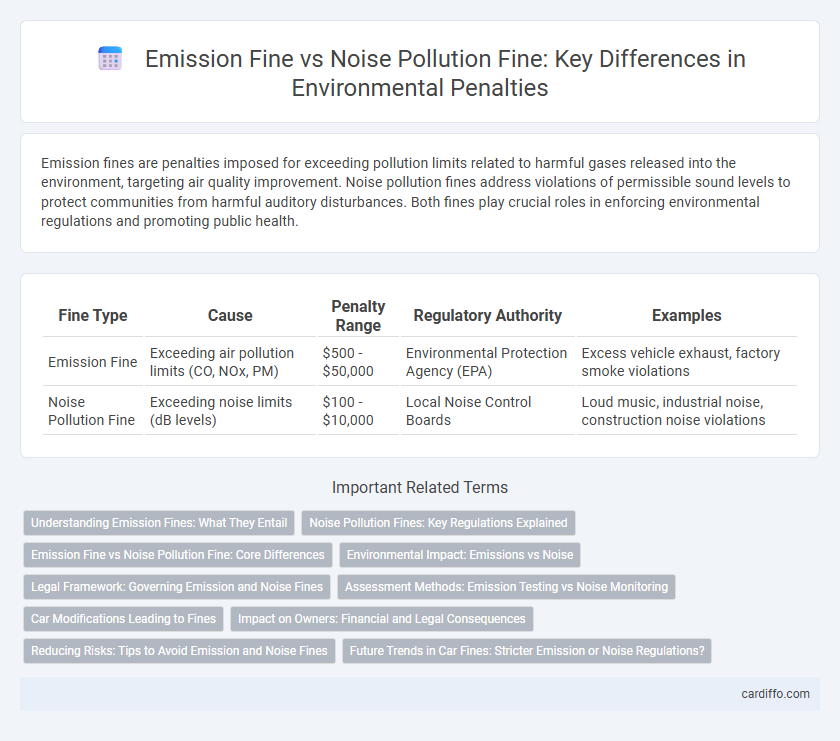Emission fines are penalties imposed for exceeding pollution limits related to harmful gases released into the environment, targeting air quality improvement. Noise pollution fines address violations of permissible sound levels to protect communities from harmful auditory disturbances. Both fines play crucial roles in enforcing environmental regulations and promoting public health.
Table of Comparison
| Fine Type | Cause | Penalty Range | Regulatory Authority | Examples |
|---|---|---|---|---|
| Emission Fine | Exceeding air pollution limits (CO, NOx, PM) | $500 - $50,000 | Environmental Protection Agency (EPA) | Excess vehicle exhaust, factory smoke violations |
| Noise Pollution Fine | Exceeding noise limits (dB levels) | $100 - $10,000 | Local Noise Control Boards | Loud music, industrial noise, construction noise violations |
Understanding Emission Fines: What They Entail
Emission fines are financial penalties imposed on individuals or businesses for exceeding legally established limits of pollutants released into the environment, such as carbon monoxide, nitrogen oxides, and particulate matter. These fines aim to enforce compliance with environmental regulations designed to reduce air pollution and mitigate climate change impacts. Understanding emission fines involves recognizing their role in promoting cleaner technologies, monitoring pollutant levels, and encouraging sustainable industrial practices.
Noise Pollution Fines: Key Regulations Explained
Noise pollution fines are imposed based on strict regulations set by environmental agencies and local governments to control excessive noise levels in residential, commercial, and industrial areas. These fines vary depending on the jurisdiction but typically escalate with repeated violations and can include substantial monetary penalties or operational restrictions. Enforcement relies on noise level measurements in decibels (dB), with many regions setting specific limits for different times of day to protect public health and well-being.
Emission Fine vs Noise Pollution Fine: Core Differences
Emission fines target pollutants released into the air, aimed at reducing harmful gases such as carbon monoxide, nitrogen oxides, and particulate matter from vehicles, industries, and power plants. Noise pollution fines focus on limiting excessive sound levels that exceed legal decibel thresholds, safeguarding public health and quality of life by controlling noise from traffic, construction, and industrial activities. Core differences lie in their regulatory focus--air quality for emission fines and auditory environment for noise pollution fines--each enforced through distinct measurement standards and mitigation requirements.
Environmental Impact: Emissions vs Noise
Emission fines target pollutants like CO2, NOx, and particulate matter that significantly contribute to climate change, respiratory diseases, and ecosystem damage. Noise pollution fines address harmful decibel levels that disrupt human health by causing stress, hearing loss, and wildlife disturbance. Prioritizing emission fines reflects their broader environmental impact on air quality and global warming, compared to the localized effects of noise pollution.
Legal Framework: Governing Emission and Noise Fines
Legal frameworks governing emission and noise pollution fines vary based on jurisdiction but commonly enforce limits through environmental protection laws and local ordinances. Emission fines are typically derived from regulations such as the Clean Air Act in the United States, which sets permissible pollutant levels and penalties for violations, while noise pollution fines are guided by standards like the Environmental Noise Directive in the European Union that regulate acceptable decibel levels. Both sets of fines aim to deter harmful practices by imposing escalating penalties for repeated offenses and require compliance monitoring through authorized inspections and technological measures.
Assessment Methods: Emission Testing vs Noise Monitoring
Emission testing involves measuring pollutants released by vehicles or industrial sources using gas analyzers and dynamometers to assess compliance with environmental standards. Noise monitoring employs sound level meters and acoustic sensors to capture decibel levels and frequency patterns in real-time, ensuring adherence to noise regulations. Both assessment methods rely on precise instrumentation but target different environmental impacts for effective fine enforcement.
Car Modifications Leading to Fines
Car modifications that increase emissions, such as removing catalytic converters or tweaking exhaust systems, often lead to hefty emission fines due to non-compliance with environmental standards. Similarly, illegal modifications that amplify noise levels beyond legal limits result in noise pollution fines reflecting local regulations designed to reduce urban noise. Authorities use sound meters and emission testing equipment to detect violations, emphasizing the importance of adhering to vehicle modification laws to avoid costly penalties.
Impact on Owners: Financial and Legal Consequences
Emission fines impose significant financial burdens on vehicle owners through costly penalties and mandatory compliance upgrades, often leading to increased maintenance expenses. Noise pollution fines result in legal repercussions such as citations and potential court appearances, affecting owners with both monetary penalties and reputational damage. Both fines can lead to increased insurance premiums and restrictions on vehicle use, intensifying the economic and legal impact on owners.
Reducing Risks: Tips to Avoid Emission and Noise Fines
Reducing risks of emission and noise pollution fines requires strict adherence to local environmental regulations and regular equipment maintenance to ensure compliance with emission limits and noise standards. Implementing noise control measures such as sound barriers and using low-emission engines or filters can significantly minimize violations. Regular monitoring and timely reporting of emission and noise levels provide proactive measures to avoid costly fines and contribute to environmental protection.
Future Trends in Car Fines: Stricter Emission or Noise Regulations?
Future trends in car fines are leaning towards stricter emission regulations as governments worldwide aim to meet climate targets and reduce air pollution, resulting in higher penalties for exceeding emission limits. Noise pollution fines are also expected to rise, particularly in urban areas prioritizing public health and quality of life, but remain secondary to emission controls. Advances in electric vehicle adoption and real-time monitoring technologies will drive enforcement efficiency and influence the evolving landscape of automotive fines.
Emission fine vs Noise pollution fine Infographic

 cardiffo.com
cardiffo.com